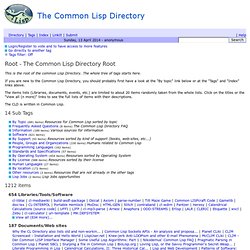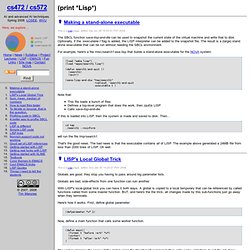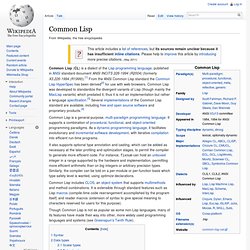

Common Lisp's Loop Macro Examples for Beginners. Custom Search - Common Lisp Search Engine. The Common Lisp Directory. 8 Comments You must be logged to add a comment Comments and Notes Welcome You can comment and/or add notes to all the tags and items of the Common Lisp Directory.

Submitted by admin 3042 days 13 hours 24 min ago Comments added to RSS feeds Now the commented items are added to the RSS feeds so that it's possible to see what have been commented recently. Submitted by marc.battyani 2982 days 17 hours 14 min ago unicode possibilities It would be nice if cl-user would display unicode input for CJK text. Submitted by charliemac 2078 days 10 hours 59 min ago universities? Common Lisp. The Common Lisp Wiki-book cover.

Common Lisp (CL) is a modern, multi-paradigm, high-performance, compiled, ANSI-standardized, prominent descendant of the long-running family of Lisp programming languages. The CL Hello World program reads as follows: (print "Hello World! ") Hello World! First steps — installation and introductory tutorials Basic topics — lists, functions and macros Advanced topics Beyond ANSI Common Lisp — Non-official standards External libraries — A sampling of the multitude of Common Lisp libraries Implementation Issues — Using Common Lisp programs in your every day work Case Studies in CL — A collection of involved examples Reference - The language's reference.
Learning AI: csx72 » Lisp. Making a stand-alone executable This is a Lisp page, written Sat Jan 26 19:43:41 PST 2008.

The SBCL function save-lisp-and-die can be used to snapshot the current state of the virtual machine and write that to disk. Optionally, if the :executable t flag is added, the LISP interpreter can be added to the snapshot file. The result is a (large) stand alone executable that can be run without needing the SBCL environment. Common Lisp Quick Reference / Cheatsheet Archive / Cheat Sheet Heap. Lisp Games Development. Common Lisp HyperSpec (TM)
Onlisp: Concept Index. Lisp Primer. Common LISP Hints. Common LISP Hints Geoffrey J. Gordon <ggordon@cs.cmu.edu> Modified by Bruno Haible <haible@ma2s2.mathematik.uni-karlsruhe.de> and Peter Van Eynde <s950045@uia.ua.ac.be> Friday, February 5, 1993 1. Successful Lisp - Contents. Common Lisp: A Gentle Introduction to Symbolic Computation. This book, with minor revisions, is back in print from Dover Publications and can be purchased in paperback form at Amazon.com, Barnes & Noble, etc. An e-book version will be released in late February, 2013. Free software accompanying the book is also available. This 1990 edition may be distributed in hardcopy form, for non-profit educational purposes, provided that no fee is charged to the recipient beyond photocopying costs. All other rights reserved. You may not redistribute the Postscript file, e.g., you may not put a copy on another web page, or include it on a CD-ROM.
Entire book -- Postscript (1.75 MB file) Entire book -- PDF (1 MB file) Figures missing from the book (780K PDF) Learning Lisp Fast. Lisp is a big and deep language. This quickstart is only intended to get you introduced to very basic concepts in Lisp, not any of the really cool stuff Lisp does. As such it's geared to how to do C in Lisp, not good functional style (no closures, no macros). It's enough to get you up to speed so you can more easily understand a good book (ANSI Common Lisp, etc.)
The quickstart also does not teach many functions -- you'll need to root around in the ANSI Common Lisp index and play with some of the functions there. The quickstart also shows you how to manipulate the command line, and to load and compile files. Don't be intimidated by the size of this file. If you're done with this tutorial, go on to Tutorial 2 and Tutorial 3. Legend Running, Breaking, and Quitting Lisp Evaluating Simple Expressions From now on, we will only use examples in clisp. Evaluating Lists as Functions Control Structures and Variables Writing Functions Lists and Symbols as Data.
Simplified Common Lisp reference. Practical Common Lisp. Common Lisp. Common Lisp is a general-purpose, multi-paradigm programming language.

It supports a combination of procedural, functional, and object-oriented programming paradigms. As a dynamic programming language, it facilitates evolutionary and incremental software development, with iterative compilation into efficient run-time programs. Though Common Lisp is not as popular as some non-Lisp languages, many of its features have made their way into other, more widely used programming languages and systems (see Greenspun's Tenth Rule).
Syntax[edit] Common Lisp is a dialect of Lisp; it uses S-expressions to denote both code and data structure. (+ 2 2) ; adds 2 and 2, yielding 4. (defvar *x*) ; Ensures that a variable *x* exists, ; without giving it a value. ;; Define a function that squares a number: (defun square (x) (* x x)) ;; Execute the function: (square 3) ; Returns 9 ;; the 'let' construct creates a scope for local variables. Data types[edit]